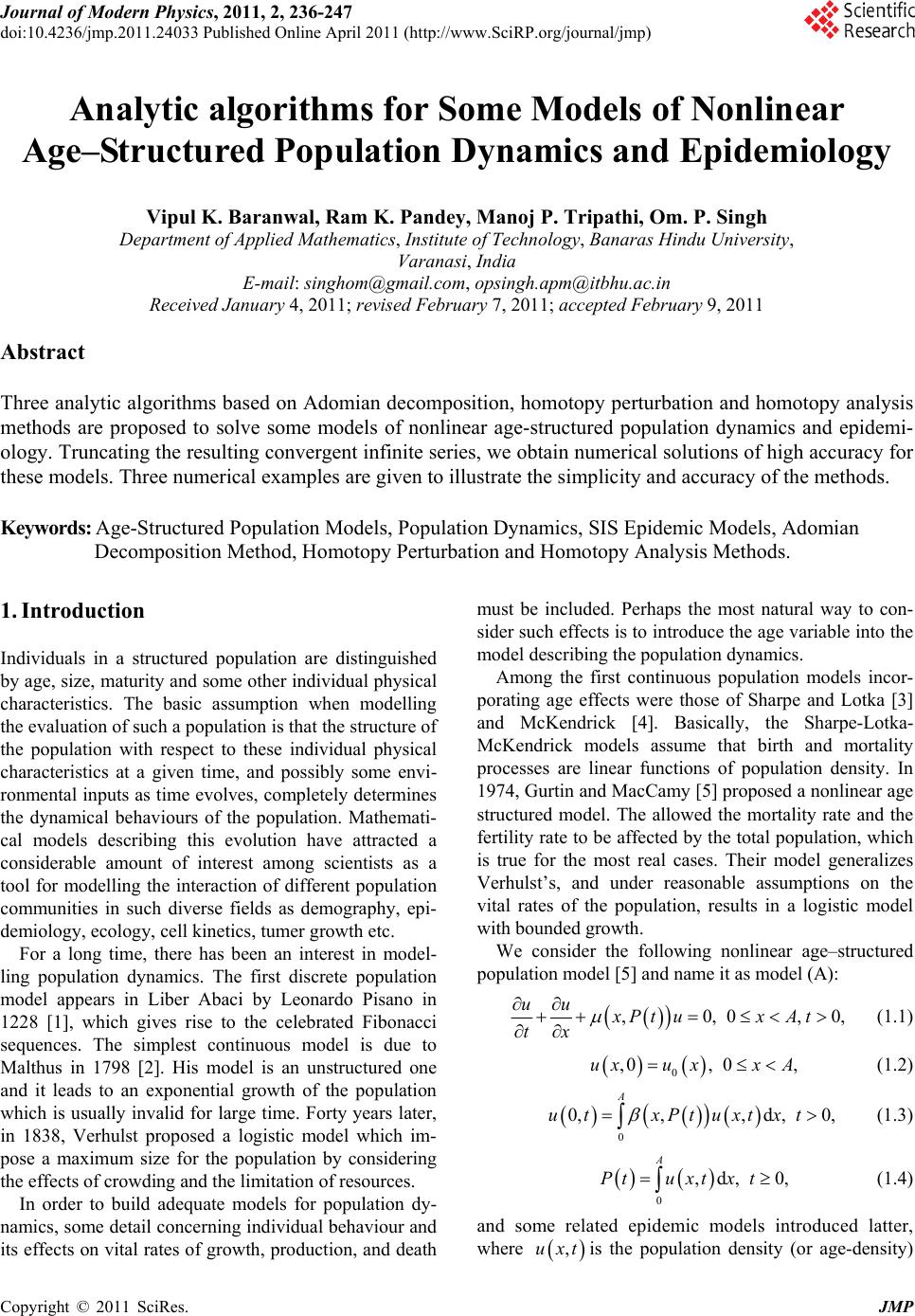 Journal of Modern Physics, 2011, 2, 236-247 doi:10.4236/jmp.2011.24033 Published Online April 2011 (http://www.SciRP.org/journal/jmp) Copyright © 2011 SciRes. JMP Analytic algorithms for Some Models of Nonlinear Age–Structured Population Dynamics and Epidemiology Vipul K. Baranwal, Ram K. Pandey, Manoj P. Tripathi, Om. P. Singh Department of Ap pl i e d M athematics, Institute of Technology, Banaras Hindu University, Varanasi, India E-mail: singhom@gmail.co m, opsingh.apm@itbhu.ac.in Received January 4, 2011; revised February 7, 2011; accepted February 9, 2011 Abstract Three analytic algorithms based on Adomian decomposition, homotopy perturbation and homotopy analysis methods are proposed to solve some models of nonlinear age-structured population dynamics and epidemi- ology. Truncating the resulting convergent infinite series, we obtain numerical solutions of high accuracy for these models. Three numerical examples are given to illustrate the simplicity and accuracy of the methods. Keywords: Age-Structured Population Models, Population Dynamics, SIS Epidemic Models, Adomian Decomposition Method, Homotopy Perturbation and Homotopy Analysis Methods. 1. Introduction Individuals in a structured population are distinguished by age, size, maturity and some other individual physical characteristics. The basic assumption when modelling the evaluation of such a population is that the structure of the population with respect to these individual physical characteristics at a given time, and possibly some envi- ronmental inputs as time evolves, completely determines the dynamical behaviours of the population. Mathemati- cal models describing this evolution have attracted a considerable amount of interest among scientists as a tool for modelling the interaction of different population communities in such diverse fields as demography, epi- demiology, ecology, cell kinetics, tumer growth etc. For a long time, there has been an interest in model- ling population dynamics. The first discrete population model appears in Liber Abaci by Leonardo Pisano in 1228 [1], which gives rise to the celebrated Fibonacci sequences. The simplest continuous model is due to Malthus in 1798 [2]. His model is an unstructured one and it leads to an exponential growth of the population which is usually invalid for large time. Forty years later, in 1838, Verhulst proposed a logistic model which im- pose a maximum size for the population by considering the effects of crowding and the limitation of resources. In order to build adequate models for population dy- namics, some detail concerning individual behaviour and its effects on vital rates of growth, production, and death must be included. Perhaps the most natural way to con- sider such effects is to in troduce the age variable in to the model describing the population dynamics. Among the first continuous population models incor- porating age effects were those of Sharpe and Lotka [3] and McKendrick [4]. Basically, the Sharpe-Lotka- McKendrick models assume that birth and mortality processes are linear functions of population density. In 1974, Gurtin and MacCamy [5] proposed a nonlinear age structured model. The allowed the mortality rate and the fertility rate to be affected by the total population, which is true for the most real cases. Their model generalizes Verhulst’s, and under reasonable assumptions on the vital rates of the population, results in a logistic model with bound ed growth. We consider the following nonlinear age–structured population model [5] and name it as model (A): ,0,0, uu xPt uxAt tx 0, (1.1) 0 ,0, 0,uxu xxA (1.2) 0 0,,,d ,0, A ut xPtuxtxt (1.3) 0 ,d, 0, A Ptuxtx t (1.4) and some related epidemic models introduced latter, where ,uxtis the population density (or age-density) 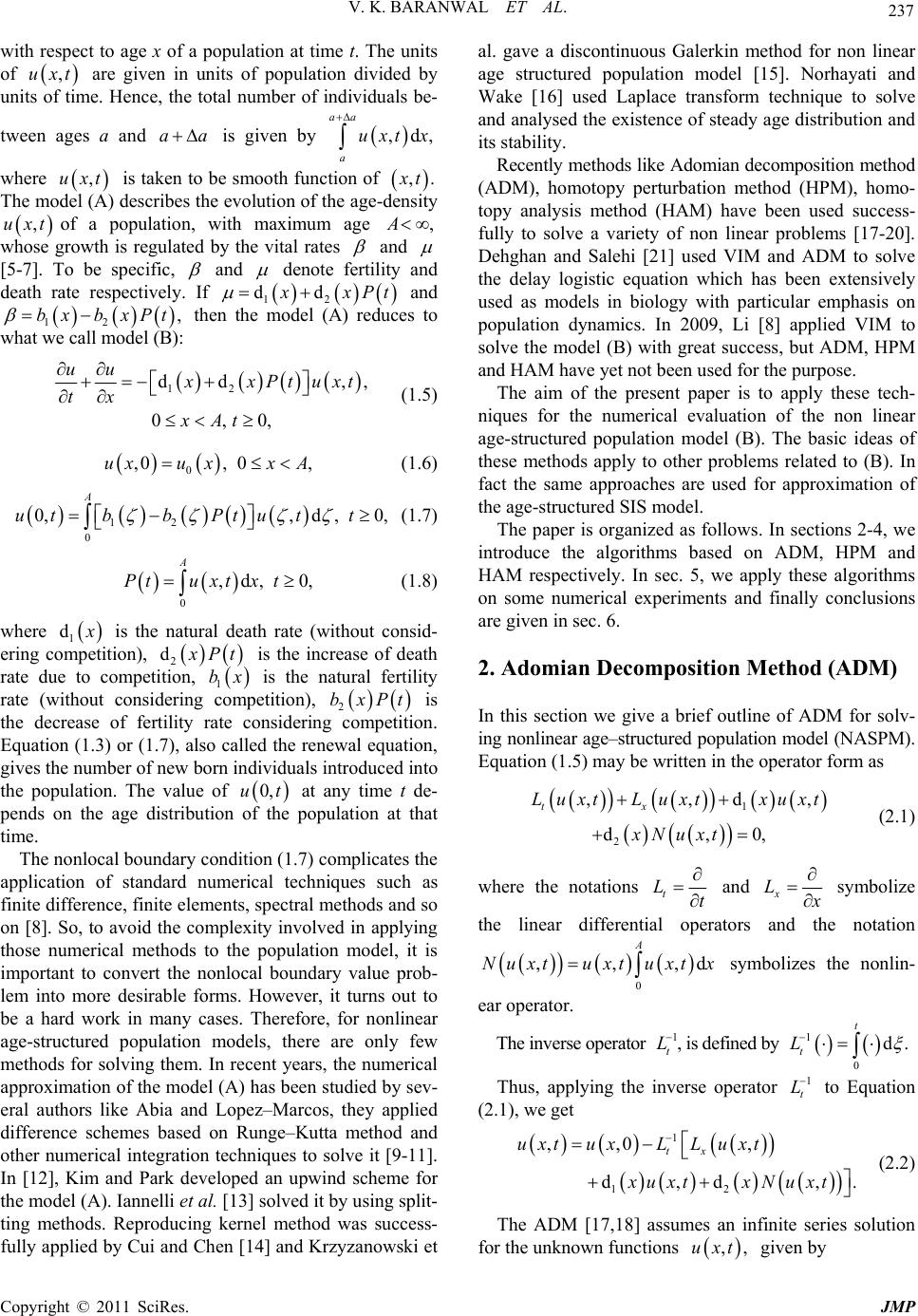 V. K. BARANWAL ET AL. 237 aa with respect to age x of a population at time t. The units of are given in units of population divided by units of time. Hence, the total number of individuals be- ,uxt ux tween ages a and is given by ,d, aa a uxt x where is taken to be smooth function of ,t ,. t ,A The model (A) describes the evolution of the age-density of a population, with maximum age ,uxt whose growth is regulated by the vital rates and [5-7]. To be specific, and denote fertility and death rate respectively. If 12 dd xPt and then the model (A) reduces to what we call model (B): bx xPt 12 b, 12 dd , 0,0, uu , xPtuxt tx xAt (1.5) 0 ,0, 0,uxu xxA (1.6) 12 0 0,,d ,0, A utbbPtu tt (1.7) 0 ,d, 0, A Ptuxtx t (1.8) where 1 d is the natural death rate (without consid- ering competition), 2 d Pt is the increase of death rate due to competition, bx 1 is the natural fertility rate (without considering competition), bxPt 2 is the decrease of fertility rate considering competition. Equation (1.3) or (1.7), also called the renewal equation, gives the number of new born individuals introduced into the population. The value of at any time t de- pends on the age distribution of the population at that time. 0,t u The nonlocal boundar y cond ition (1.7) complicates the application of standard numerical techniques such as finite difference, finite elements, spectral methods and so on [8]. So, to avoid the complexity involved in applying those numerical methods to the population model, it is important to convert the nonlocal boundary value prob- lem into more desirable forms. However, it turns out to be a hard work in many cases. Therefore, for nonlinear age-structured population models, there are only few methods for solving them. In recent years, the numerical approximation of the model (A) has been studied by sev- eral authors like Abia and Lopez–Marcos, they applied difference schemes based on Runge–Kutta method and other numerical integration techniques to solve it [9-11]. In [12], Kim and Park developed an upwind scheme for the model (A). Iannelli et al. [13] solved it by using sp lit- ting methods. Reproducing kernel method was success- fully applied by Cui and Chen [14] and Krzyzanowski et al. gave a discontinuous Galerkin method for non linear age structured population model [15]. Norhayati and Wake [16] used Laplace transform technique to solve and analysed the existence of steady age distribution and its stability. Recently methods like Ado mian decomposition method (ADM), homotopy perturbation method (HPM), homo- topy analysis method (HAM) have been used success- fully to solve a variety of non linear problems [17-20]. Dehghan and Salehi [21] used VIM and ADM to solve the delay logistic equation which has been extensively used as models in biology with particular emphasis on population dynamics. In 2009, Li [8] applied VIM to solve the model (B) with great success, but ADM, HPM and HAM have yet not been used for the pur pose. The aim of the present paper is to apply these tech- niques for the numerical evaluation of the non linear age-structured population model (B). The basic ideas of these methods apply to other problems related to (B). In fact the same approaches are used for approximation of the age-structured SIS model. The paper is organized as follows. In sections 2-4, we introduce the algorithms based on ADM, HPM and HAM respectively. In sec. 5, we apply these algorithms on some numerical experiments and finally conclusions are given in sec. 6. 2. Adomian Decomposition Method (ADM) In this section we give a brief outline of ADM for solv- ing nonlinear age–structured population model (NASPM). Equation (1.5) may be written in the operator form as 1 2 ,,d d,0, tx Lu xtLu xtxu xt xNuxt , (2.1) where the notations t Lt and x L symbolize the linear differential operators and the notation symbolizes the nonlin- ear operator. 0 ,,, A Nuxtuxtuxt xd The i nvers e op erat or 1 t L , is de fined by 1 0 d t t L . Thus, applying the inverse operator to Equation (2.1), we get 1 t L 1 12 ,,0, d,d , tx uxtuxLL uxt xuxt xNuxt . (2.2) The ADM [17,18] assumes an infinite series solution for the unknown functions given by ,,uxt Copyright © 2011 SciRes. JMP  V. K. BARANWAL ET AL. Copyright © 2011 SciRes. JMP 238 ,[17,18]. For a given nonlinear operator ,Nuxt, these polynomials are calculated using the ba sic formula: 0 , n n uxtu xt . (2.3) The nonlinear ope rato r ,Nuxt ,, n is decomposed as 012 00 1d ,,,,, 0. !d nk nn k nk Auuu uNun n (2.5) 012 0 ,,,, n n NuxtAu uuu (2.4) The above formula is used to set a computer code to compute the various Adomian polynomials . n The first few polynomials are given as follows: where n is an approximate Adomian’s polynomial which can be calculated for all forms of nonlinearity ac- cording to specific algorithms constructed by Adomian 23 11 00101202 03 03 0120 ,, , 2! 3! uu A NuANuuA Nuu NuA NuuNuuu Nu ,. 0 n n Substituting (2.3) and (2.4) in (2.2), we get 112 000 ,0d d. ntxnn nnn uuxLLux uxA (2.6) Identifying the zeroth component by the ini- tial condition we obtain the subsequent com-ponents by the following recursive formula 0,uxt ,0 ,ux 1 01 12 ,,0,,,d ,d ntxn n uxtuxuxtL LuxtxuxtxA . n (2.7) We construct a homotopy ,: 0,1vrp R sat- isfying 3. Homotopy Perturbation Method (HPM) 0 ,1 0,1 ,. HvppLvLupAvfr pr In this method, using the homotopy technique of topol- ogy, a homotopy is constructed with an embedding pa- rameter 0,1p which is considered as a “small pa- rameter”. This method became very popular amongst the scientists and engineers, even though it involves con- tinuous deformation of a simple problem into a more difficult problem under consideration. Most of the per- turbation methods depend on the existence of a small perturbation parameter but many nonlinear problems have no small perturbation parameter at all. Many new methods have been proposed in the late nineties to solve such nonlinear equation devoid of such small parameters. Late 1990s saw a surge in applications of homotopy the- ory in the scientific and engineering computations [19]. When the homotopy theory is coupled with perturbation theory it provides a powerful mathematical tool. To il- lustrate the basic concept of HPM, consider the follow- ing nonlinear functional eq uation 0, (3.2) Hence, 00 ,0HvpLvLupLupNvfr , (3.3) where 0 is an initial approximation for the solution of (3.1). As u 0 ,0and ,1, vLvLu HvAvfr(3.4) it shows that , vp continuously traces an implicitly defined curve from a starting point to a solu- tion 0,0Hu ,1Hv . The embedding parameter p increases monotonously from zero to one as the trivial linear part 0Lu deforms continuously to the original problem . ufr The embedding parameter 0, 1p can be considered as an expanding parameter [19] to obtain ,,Auf rr 2 01 2.vvpvpv (3.5) with the boundary conditions ,0, u Bu r n , The solution is obtained by taking the limit as p tends to 1 in equation.(3.5). Hence (3.1) where A is a general functional operator, B is a boundary operator, r is a known analytic function, and is the boundary of the domain . The operator A is decomposed as , LN where L is the linear and N is the nonlinear operator. Hence Equation (3.1) can be writ- ten as 012 1 lim . p uvvvv (3.6) The series (3.6) converges for most cases and the rate of convergence depends on . ufr For nonlinear age-structured population model, we choose the initial approximation 00 ,,uxt ux and construct the following homotopy: 0, .LuNuf rr 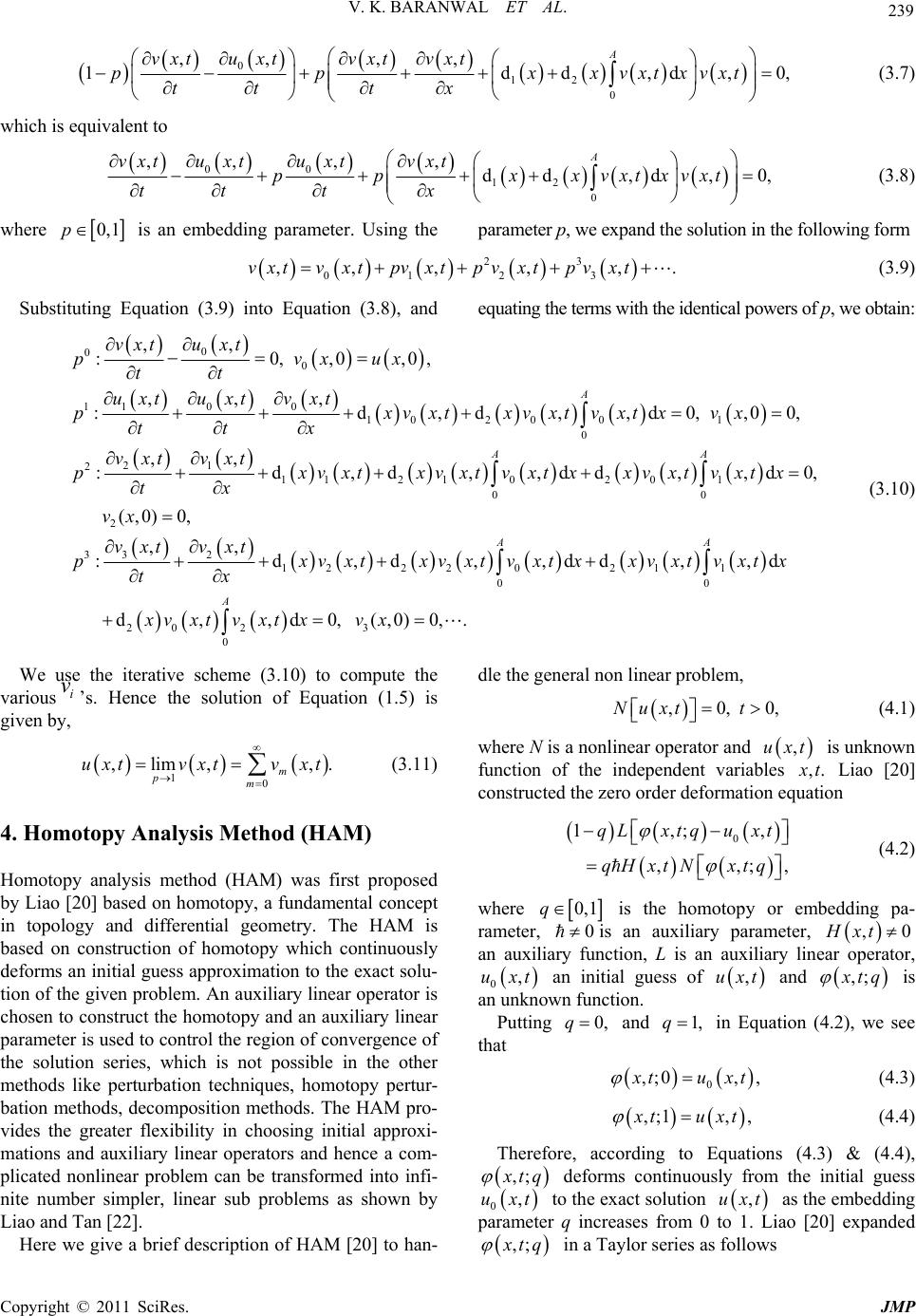 V. K. BARANWAL ET AL. 239 012 0 ,, ,, 1dd A vxtu xtvxtvxt pp xxvxtx tt tx ,d,0,vxt (3.7) which is equivalent to 00 12 0 ,, , , dd ,d, A vxtuxtu xtvxt pp xxvxtxvxt tt tx 0 , (3.8) where 0,1p is an embedding parameter. Using the parameter p, we expand the solution in the following form 23 01 2 3 ,, ,,,vxt vxt pvxt pvxt pvxt . (3.9) Substituting Equation (3.9) into Equation (3.8), and eq u a ti ng t h e t er ms w i th th e id e n t i ca l p o w e r s o f p, we obtain: 0 00 100 11020 01 0 21 2112102 01 00 2 32 3 ,, :0,,0,0, ,,, :d,d,,d0, ,, :d,d,,dd, (,0)0, ,, : A AA vxtu xt pvxux tt uxt uxt vxt pxvxtxvxtvxtx vx ttx vxt vxt pxvxtxvxtvxtxxvxtvxt x tx vx vxt vxt pt ,00, ,d0, 1222021 1 00 20 23 0 d,d,,d d,,d d,,d0,(,0)0,. AA A xvxtxvxtvxtxxvxtv xtx x xvxtvxtxv x (3.10) We use the iterative scheme (3.10) to compute the various ’s. Hence the solution of Equation (1.5) is given by, i v 10 ,lim, , m pm uxtvxtv xt . (3.11) 4. Homotopy Analysis Me t h o d (HAM) Homotopy analysis method (HAM) was first proposed by Liao [20] based on homotopy, a fundamental concept in topology and differential geometry. The HAM is based on construction of homotopy which continuously deforms an initial guess approximation to the exact solu- tion of the given problem. An auxiliary linear operator is chosen to construct the homotopy and an auxiliary linear parameter is used to control the region of convergence of the solution series, which is not possible in the other methods like perturbation techniques, homotopy pertur- bation methods, decomposition methods. The HAM pro- vides the greater flexibility in choosing initial approxi- mations and auxiliary linear operators and hence a com- plicated nonlinear problem can be transformed into infi- nite number simpler, linear sub problems as shown by Liao and Tan [22]. Here we give a brief description of HAM [20] to han- dle the general non linear problem, ,0,Nuxt t 0, (4.1) where N is a nonlinear operator and is unknown function of the independent variables ,uxt ,. t Liao [20] constructed the zero order deformation equation 0 1,; ,,; q Lxtquxt qHxtN xtq , , (4.2) where 0, 1q0 is the homotopy or embedding pa- rameter, is an auxiliary parameter, ,0Hxt an auxiliary function, L is an auxiliary linear operator, t 0 an initial guess of and ,ux ,uxt ,; tq is an unknown function. Putting 0,q and 1,q in Equation (4.2), we see that 0 ,;0,, tuxt (4.3) ,;1,, tuxt (4.4) Therefore, according to Equations (4.3) & (4.4), ,; tq deforms continuously from the initial guess 0,uxt to the exact solution as the embedding parameter q increases from 0 to 1. Liao [20] expanded ,uxt ,; tq in a Taylor series as follows Copyright © 2011 SciRes. JMP 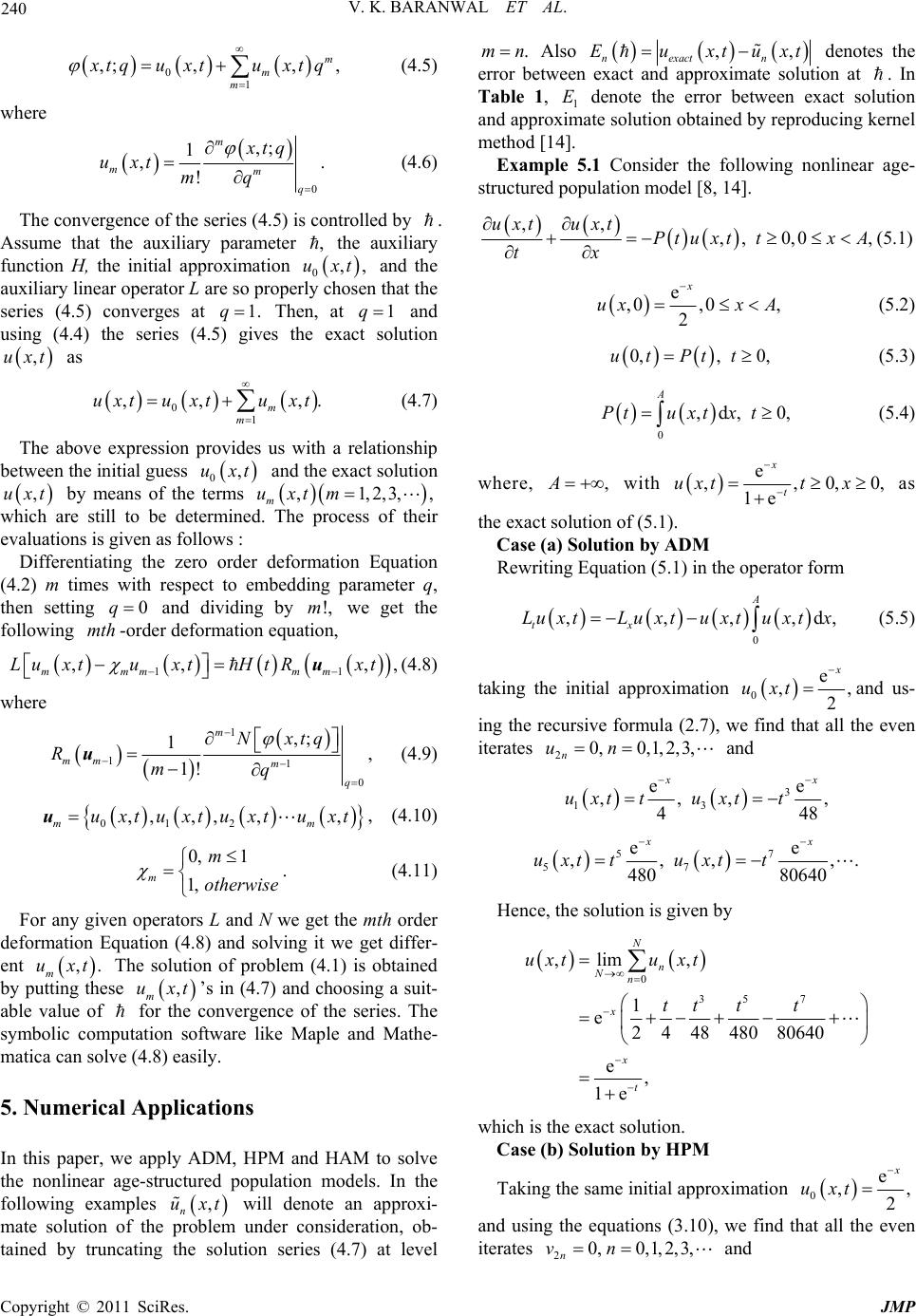 240 V. K. BARANWAL ET AL. 01 ,;,, , m m m tqu xtuxtq (4.5) where 0 ,; 1 ,! m mm q xtq uxtmq . (4.6) The convergence of the series (4.5) is controlled by . Assume that the auxiliary parameter the auxiliary function H, the initial approximation and the auxiliary linear operator L are so properly chosen that the series (4.5) converges at , 0 ux ,,t 1.q Then, at 1q and using (4.4) the series (4.5) gives the exact solution as ,uxt ,. 01 ,, m m uxtu xtuxt (4.7) The above expression provides us with a relationship between the initial guess and the exact solution by means of the terms 0,uxt ,uxt ,1,2,3, m uxtm, ,, which are still to be determined. The process of their evaluations is given as follows : Differentiating the zero order deformation Equation (4.2) m times with respect to embedding parameter q, then setting and dividing by we get the following -order deformation eq uat i on, 0q h!,m mt 11 ,, mmm mm L uxtuxtH tRxt u(4.8) where 1 11 0 ,; 1 1! m mm m q Nxtq Rmq u, (4.9) 012 ,, ,,,, mm uxt u xt uxtuxtu , (4.10) 0, 1 1, m m otherwise . (4.11) For any given operators L and N we g et the mth order deformation Equation (4.8) and solving it we get differ- ent The solution of problem (4.1) is obtained by putting these ’s in (4.7) and choosing a suit- able value of for the convergence of the series. The symbolic computation software like Maple and Mathe- matica can solve (4.8) easily. ,. m uxt , m uxt 5. Numerical Applications In this paper, we apply ADM, HPM and HAM to solve the nonlinear age-structured population models. In the following examples will denote an approxi- mate solution of the problem under consideration, ob- tained by truncating the solution series (4.7) at level , n uxt .mn Also , n exactn Euxtux ,t denotes the error between exact and approximate solution at . In Table 1, 1 denote the error between exact solution and approximate solution obtained by reproducing kernel method [ 14] . E Example 5.1 Consider the following nonlinear age- structured pop ul a ti on model [8, 14]. ,, ,, 0,0 uxt Ptuxt tx tx ,A uxt (5.1) e ,0 ,0, 2 x uxx A (5.2) 0,, 0,utPtt (5.3) 0 ,d, 0, A Ptuxtx t (5.4) where, ,A with e ,, 0,0, d, 1e x t uxtt x as the exact solution of (5.1). Case (a) Solution by ADM Rewriting Equation (5.1) in the operator form 0 ,,,, A tx u xtLuxtu xtu xtx L (5.5) taking the initial approximation 0e , , 2 uxt and us- ing the recursive formula (2.7), we find that all the even iterates 20, 0,1,2,3, n un and 3 13 ee ,,, 44 , 8 x uxt tuxtt 57 57 ee ,,, ,. 480 80640 xx uxt tuxtt Hence, the solution is given by 0 35 7 ,lim , 1 e2 4 48 48080640 e, 1e N n Nn x x t uxtu xt tt tt which is the exact solution. Case (b) Solution by HPM Taking the same initial appro ximation 0e 2 ,, uxt and using the equations (3.10), we find that all the even terates i20, 0,1,2,3, n vn and Copyright © 2011 SciRes. JMP  V. K. BARANWAL ET AL. Copyright © 2011 SciRes. JMP 241 Table 1. Comparison between HAM and reproducing kernel method solutions. Nodes t x Exact Solution ,uxt Approximate Solution 7,,uxt 1 Error 77 1, ,Euxtux t Error [14] 1 E 0.00 0.00 0.5 0.5 0 0 0.20 0.00 0.549834 0.549834 1.08906E 11 2.6162E 02 0.40 0.00 0.598688 0.598688 5.50928E 09 4.4321E 02 0.60 0.00 0.645656 0.645656 2.07654E 07 4.4703E 02 0.80 0.00 0.689974 0.689972 2.69192E 06 3.6536E 02 1.00 0.00 0.731059 0.731039 1.93921E 05 1.1234E 02 0.00 1.00 0.18394 0.18394 0 0 0.20 1.00 0.202273 0.202273 4.00643E 12 6.467E 03 0.40 1.00 0.220245 0.220245 2.02675E 09 1.2146E 02 0.60 1.00 0.237524 0.237524 7.63918E 08 1.4046E 02 0.80 1.00 0.253827 0.253826 9.90302E 07 7.887E 03 1.00 1.00 0.268941 0.268934 7.13396E 06 5.552E 03 0.00 2.00 0.0676676 0.0676676 0 0 0.20 2.00 0.0744119 0.0744119 1.47389E 12 5.5869E 03 0.40 2.00 0.0810236 0.0810236 7.456E 10 9.6181E 03 0.60 2.00 0.0873801 0.0873801 2.8103E 08 1.03579E 02 0.80 2.00 0.0933779 0.0933775 3.64312E 07 5.4159E 03 1.00 2.00 0.098938 0.0989354 2.62444E 06 6.5159E 03 0.00 3.00 0.0248935 0.0248935 0 0 0.20 3.00 0.0273746 0.0273746 5.42216E 13 4.4722E 03 0.40 3.00 0.0298069 0.0298069 2.74291E 10 7.3509E 03 0.60 3.00 0.0321453 0.0321453 1.03385E 08 8.2104E 03 0.80 3.00 0.0343518 0.0343517 1.34023E 07 6.4072E 03 1.00 3.00 0.0363973 0.0363963 9.65477E 07 2.9965E 03 0.00 4.00 0.00915782 0.00915782 0 0 0.20 4.00 0.0100706 0.0100706 1.99471E 13 1.8242E 03 0.40 4.00 0.0109653 0.0109653 1.00906E 10 3.2864E 03 0.60 4.00 0.0118256 0.0118256 3.80332E 09 3.7749E 03 0.80 4.00 0.0126373 0.0126373 4.93043E 08 3.1609E 03 1.00 4.00 0.0133898 0.0133894 3.55179E 07 1.8526E 03 0.00 5.00 0.00336897 0.00336897 0 0 0.20 5.00 0.00370475 0.00370475 7.33805E 14 3.3172E 04 0.40 5.00 0.00403393 0.00403393 3.71212E 11 2.5414E 04 0.60 5.00 0.0043504 0.0043504 1.39916E 09 1.3464E 04 0.80 5.00 0.00464901 0.00464899 1.8138E 08 3.5880E 04 1.00 5.00 0.00492583 0.0049257 1.30663E 07 8.72E 04 0.00 6.00 0.00123938 0.00123938 0 0 0.20 6.00 0.0013629 0.0013629 2.69953E 14 8.9154E 04 0.40 6.00 0.001484 0.001484 1.36561E 11 2.3233E 03 0.60 6.00 0.00160042 0.00160042 5.14724E 10 3.85194E 03 0.80 6.00 0.00171028 0.00171027 6.67261E 09 5.38069E 03 1.00 6.00 0.00181211 0.00181206 4.80683E 08 6.49366E 03 0.00 8.00 0.000167731 0.000167731 0 0 0.20 8.00 0.000184449 0.000184449 3.65338E 15 4.58849E 03 0.40 8.00 0.000200837 0.000200837 1.84816E 12 6.31876E 03 0.60 8.00 0.000216594 0.000216593 6.96603E 11 9.81151E 03 0.80 8.00 0.000231461 0.00023146 9.03039E 10 1.30453E 02 1.00 8.00 0.000245243 0.000245236 6.50533E 09 1.6041E 02 0.00 10.00 0.0000227 0.0000227 0 0 0.20 10.00 0.0000249624 0.0000249624 4.94433E 16 2.14306E 04 0.40 10.00 0.0000271804 0.0000271804 2.50121E 13 1.14205E 03 0.60 10.00 0.0000293128 0.0000293127 9.42749E 12 2.52654E 03 0.80 10.00 0.0000313248 0.0000313247 1.22213E 10 3.89648E 03 1.00 10.00 0.00003319 0.0000331891 8.80401E 10 5.20734E 03 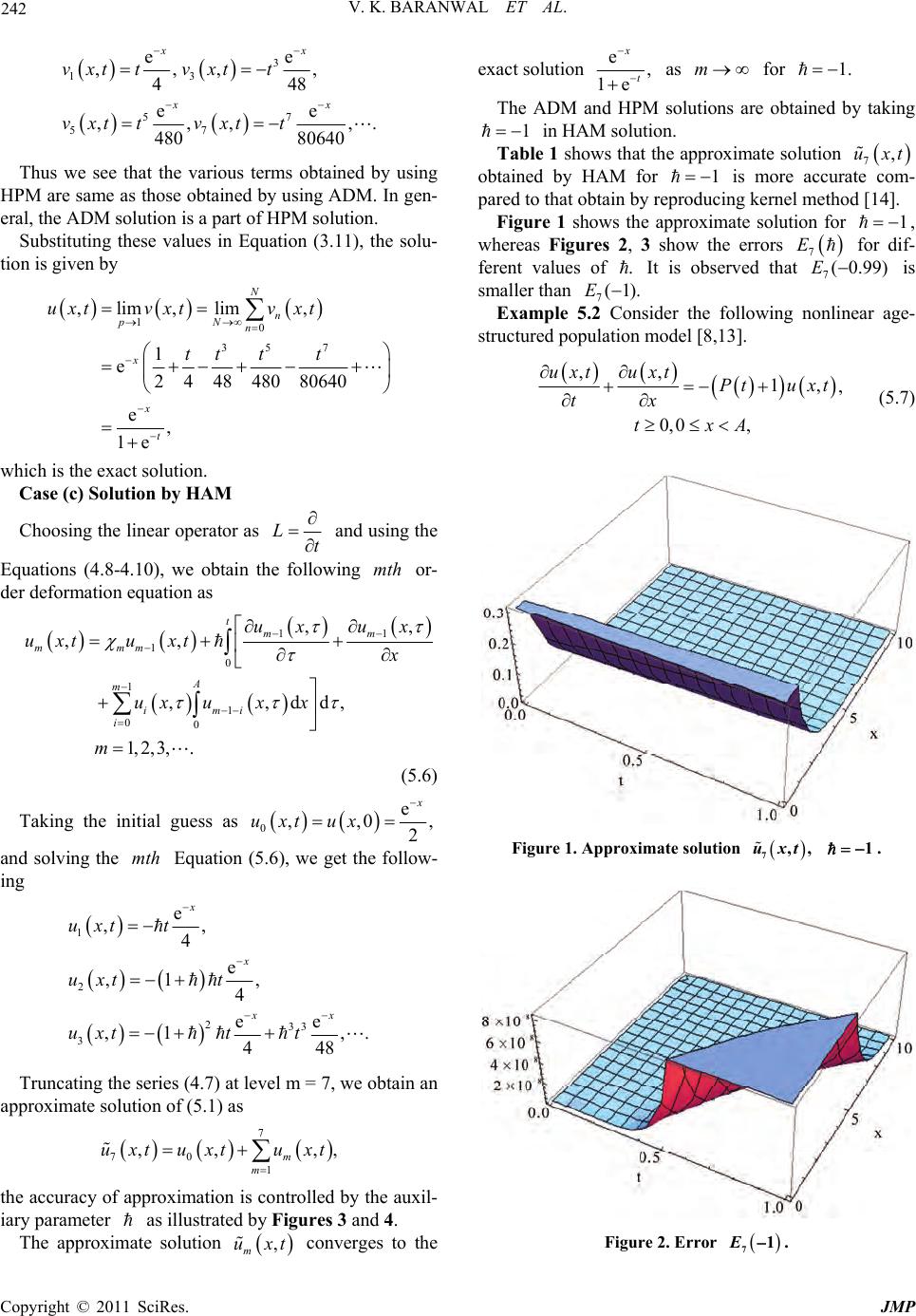 V. K. BARANWAL ET AL. Copyright © 2011 SciRes. JMP 242 3 13 57 57 ee ,,, , 448 ee ,,, 480 80640 xx xx vxt tvxtt vxt tvxtt , . Thus we see that the various terms obtained by using HPM are same as those obtained by using ADM. In gen- eral, the ADM solution is a part of HPM solution. Substituting these values in Equation (3.11), the solu- tion is give n b y 10 35 7 ,lim ,lim, 1 e244848080640 e, 1e N n pN n x x t uxtvxtvxt tt tt which is the exact solution. Case (c) Solution by HAM Choosing the linear operator as Lt and using the Equations (4.8-4.10), we obtain the following or- der deformation equation as mth 11 0 0 1 1 1 0 ,, , 1, 2, 3, ,, ,,dd . tmm A m i mmm mi i uxux x u uxt x u x t m ux x (5.6) Taking the initial guess as 0,,0 2 e, uxtux and solving the Equation (5.6), we get the follow- ing mth 1 2 233 3 e ,, 4 e ,1 , 4 ee ,1 , 448 x x xx uxt t uxt t uxtt t . , , Truncating the series (4.7) at level m = 7, we obtain an approximate solution of (5.1) as 7 70 1 ,, m m uxtuxtuxt the accuracy of approximation is controlled by the auxil- iary parameter as illustrated by Figures 3 and 4. The approximate solution converges to the , m uxt exact solution e, 1e x t as for m 1. The ADM and HPM solutions are obtained by taking 1 in HAM solution. Table 1 shows th at the approximate solution 7,uxt obtained by HAM for 1 is more accurate com- pared to that obtain by reproducing kernel method [14]. Figure 1 shows the approximate solution for 1 (0.99) , whereas Figures 2, 3 show the errors for dif- ferent values of It is observed that 7 E 7 E . is smaller than 7(1).E Example 5.2 Consider the following nonlinear age- structured po p ula t i on m odel [ 8, 13]. ,, 1, 0,0 , uxtuxtPt uxt tx txA , (5.7) Figure 1. Approximate solution 7,, uxt 1 . Figure 2. Error 71E. 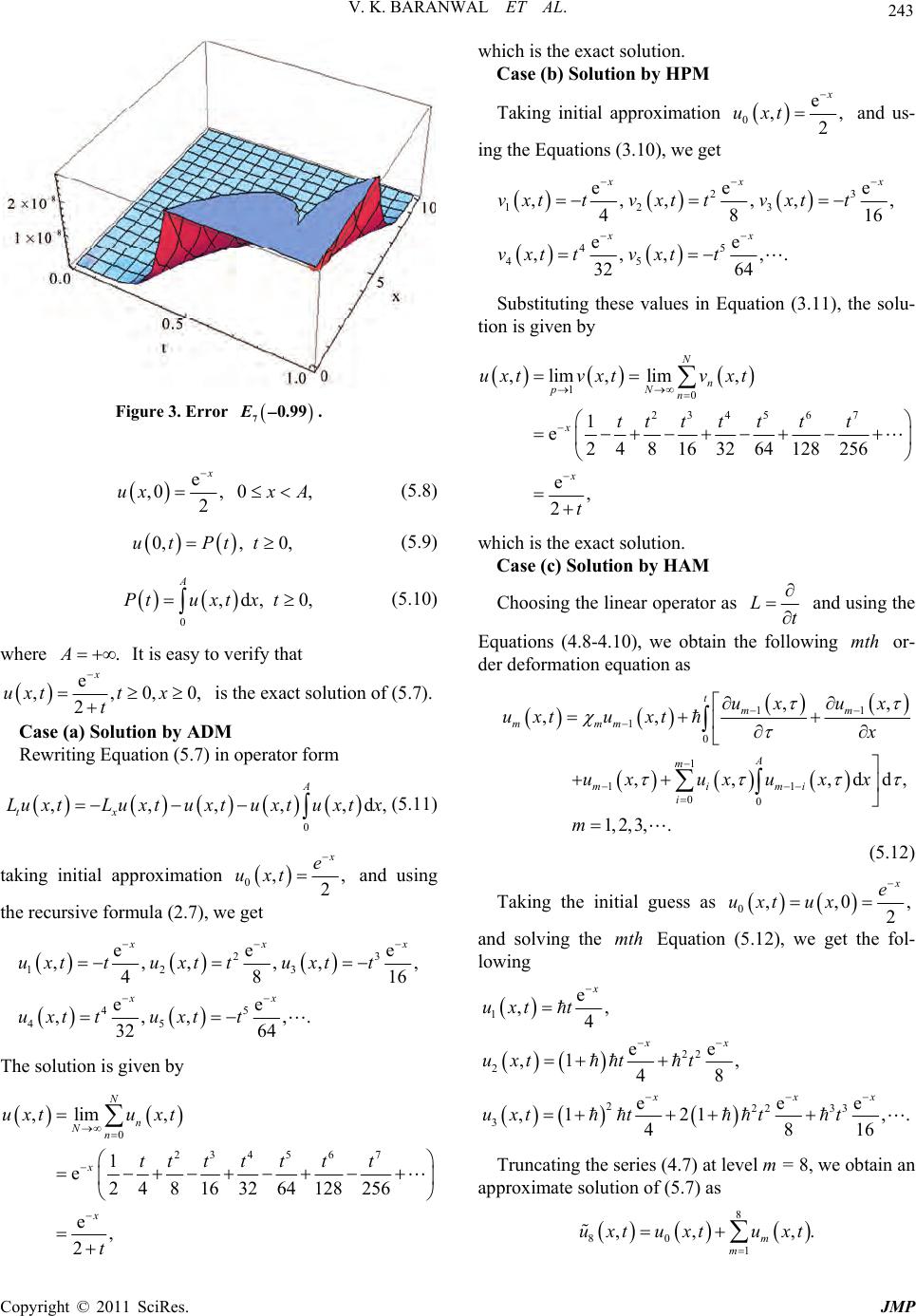 V. K. BARANWAL ET AL. 243 Figure 3. Error . 70.99E e ,0,0, 2 x uxxA (5.8) 0,, 0,utPtt (5.9) 0 ,d, 0, A Ptuxtx t (5.10) where It is easy to verify that .A e ,, 0,0, 2 x uxtt x t is the exact solution of (5.7). Case (a) Solution by ADM Rewriting Equation (5.7) in operator form 0 ,,,,, A tx Lu xtLu xtu xtu xtu xtx d, (5.11) taking initial approximation 0, 2, e uxt and using the recursive formula (2.7), we get 2 123 45 45 ee ,,,,, 48 ee ,,,,. 32 64 3 e , 16 x xx uxttuxttuxtt uxttuxtt x The solution is given by 0 23 4 567 ,lim , 1 e248163264128256 e, 2 N n Nn x x uxtu xt tt ttttt t hich is the exact solution. wCase (b) Solution by HPM Taking initial approximation 0e ,, 2 uxt and us- ing the Equat i o ns (3 .10), we get 23 123 45 45 ee e ,,,,, , 48 16 ee ,,, ,. 32 64 xx xx vxttvxttvxtt vxt tvxtt Substituting these values in Equation (3.11), the solu- tio n is given by 10 23 4 567 ,lim ,lim, 1 e2 4816 3264128 256 e, 2 N n pN n x x uxtvxtvxt tt ttttt t which is the exact solution. as Case (c) Solution by HAM Choosing the linear operator Lt and using the Eqe follouations (4.8-4.10), we obtain thwing mth or- der deformation equation as 11 0 1 11 00 1 ,, ,,,d . ,, , 1, 2, 3, d mm A m m m imi i mm uxux x ux uxtu xt uu m xxx t (5.12) Taking the initial guess as 0,,0 2 e,uxt ux an .12), we get the fold solving the mth Equation (5- lowing 1 22 2 22233 3 e ,, 4 ee ,1 , 48 ee ,1 21, 48 x xx xx uxt t uxtt t uxttt t e . 16 x Truncating the series (4.7) at level m = 8, we obtain an ap ,. proximate solution of (5.7) as uxt uxt 8 80 1 ,, m m u xt Copyright © 2011 SciRes. JMP  V. K. BARANWAL ET AL. 244 The approximate solution converges to the exact solution , m uxt e, 2t Figure 4 shows the approxlution for 1 x as m for imate so 1. , or dif- 905) is whereas Figur 6 show errors fes 5, the fere lunlethal dise 8 E SIS m nt values of . It is observed that 8( 0.7E smaller than 8(1).E In the next example, we consider a odel de- scribing the evotion of a human noase which does nort impot immunity [23-25]. Some infec- tions, for example the group of those responsible for the common cold, do not confer any long lasting immunity. Such infections do not have a recovered state and indi- viduals become su sceptible again after infection. Maybe, the most specific parameter of biological system is the age, and, especially for some infectious diseases, it has a deep influence on the dynamics of its spreading in a population. Many of the parameters may depend on age, especially the contact rate, which summarizes the ‘infec- tious effectiveness’ of contacts between susceptible and infectious subjects. This effectiveness has, thus, to take into account both the age of the infectious and the age of the susceptible. Epidemic models modelling the age structure of a popu lation are very complex. Example (5.3) illustrates the utility of our algorithm on such types of complex models. Example 5.3 We consider the following age-structured SIS model [13]: ,, 1,,,, uxt uxtuxtixtuxtPt tx 10,0 , x txA (5.13) (5.14) where ,02 1,0,uxxxA 0 0,,,d , A ut xiuxtxt 0, (5.15) 0 ,d, 0. A Ptuxt xt (5.16) 2 1,4 1 x or πsin π. take a stead y state distri-Fowe ch that r the total population, bution su ,41ixt x . Then the exact solu- tion of (5.13) is 2 41 ,. t 1 uxt Following the in the previous ex- e procedures adopted the three methods and obtain the vari- ou amples, we apply s iterates of the solution as follows: As ADM and HPM iterates are identical for 1,p we list them once. 1) ADM and HPM iterates Figure 4. Approximate solution 8,, uxt 1 . 81E. Figure 5. Error Figure 6. Error 80.7905E. Copyright © 2011 SciRes. JMP 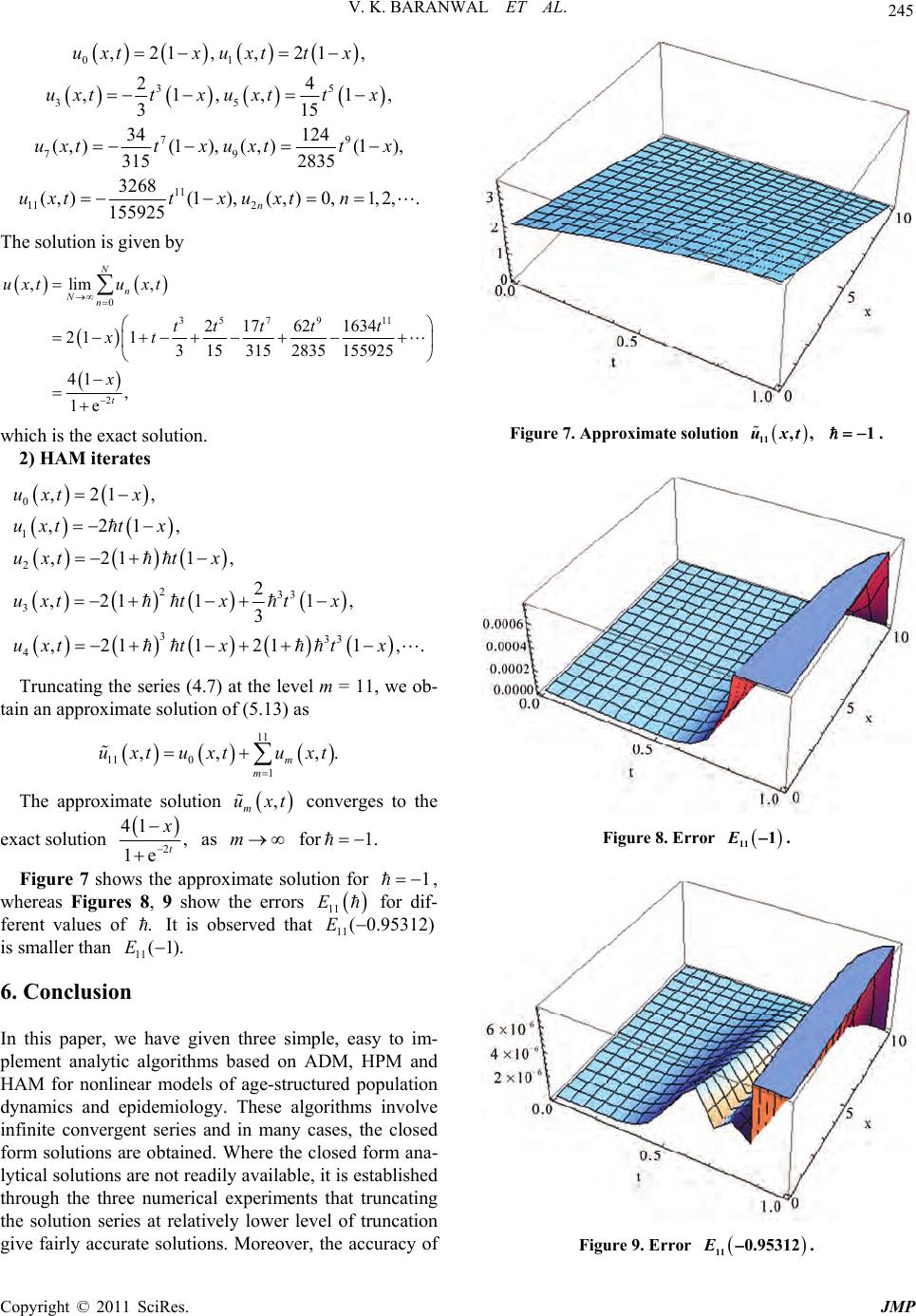 V. K. BARANWAL ET AL. 245 01 35 35 79 79 11 11 2 ,21,,21, 24 ,1,,1 315 34 124 (,)(1),(,)(1), 315 2835 3268 ( ,)(1),( ,)0,1,2,. 155925 n uxtxuxtt x uxtt xuxtt x uxtt xuxtt x uxtt xuxtn , The solution is given by 0 35 7911 2 ,lim , 2 17621634 21 1 3153152835 155925 41 , 1e N n Nn t uxtu xt tt ttt xt x which is the exact solution. 2) HAM iterates 0 1 2 233 3 333 4 ,21, ,21, ,21 1, 2 ,21 11, 3 ,211211,. uxt x uxtt x uxttx uxtt xtx uxtt xtx Truncating the series (4.7) at the level m = 11, we ob- tain an approximate solution of (5.13) as ,. The approximate solution converges to the ex 11 11 01 ,, m m uxt uxtuxt , m uxt act solution 2 41 , t 1e as m fo Figure 7 shows the approximate solution for r1. 1 , for dif- .95312) whereas Figures 8, 9 show the errors ferent values ofIt is observed th is smaller than 6. Conclusion In this paper, we have given three simple, easy to im- pl rithms involve infinite convergent series and in many cases, the closed form solutions are obtained. Where the closed form ana- ly ailab th xperime ies at rel lowerl of trucation give fairly accurate solutions. Moreover, the accuracy of 11 E at 11( 0E . 11 E (1). ement analytic algorithms based on ADM, HPM and HAM for nonlinear models of age-structured population dynamics and epidemiology. These algo tical solutions are not readily avle, it is established rough the threenumerical ents that truncating the solution seratively leven Figure 7. Approximate solution 11 ,, uxt 1 . Figure 8. Error 11 1E. 11 0.95312E. Figure 9. Error Copyright © 2011 SciRes. JMP  V. K. BARANWAL ET AL. 246 e solution may be increased by the suitable choice of the auxiliary parameter in HAM. Table 1 clearly establishes the accuracy of our method compared to that of the reproducing kernel method proposed by Cui and Chen [14]. 7. Acknowledgements The first and third authors acknowledge the financial support from UGC and CSIR New-Delhi, India, respec tively under JRF schemes. 8. References [1] L. Sigler, F. L. Abaci, “A Translation into Modern lish of Leonardo Pisano’s Book of Calculation, Springer-Verlag, New-York, 2002. [2] T. R. M the Principle of Population, ,” Philosophical Magzine, Vol. 21, No. 124, 1911, lications of Mathematics to th - Eng- ” althus, “An Essay on St. Paul’s, London,” 1798, In: T. R. Malthus, “An Essay on the Principle of Population and A Summary View of the Principle of Population,” Penguin, Harmondsworth, England, 1970. [3] F. R. Sharpe and A. J. Lotka, “A Problem in Age Distri- butions pp. 435-438. 4] A. G. McKendrick, “App[ Medical Problems,” Proceedings of Edinburgh Mathe- matical Society, Vol. 44, 1926, pp. 98-130. doi:10.1017/S0013091500034428 5] M. E. Gurtin and R. C. M[acCamy, “Nonlinear Ag ynamics,” Archive for Rational Analysis, Vol. 54, No. 3, 1974, pp. 281- 300. cerche, Pisa, 1995. Models,” Computers and e-De- pendent Population D Mechanics and [6] M. Iannelli, “Mathematical Theory of Age-Structured Population Dynamic s,” Applied Mathematics Monographs, Vol. 7, Consiglio Nazionale delle Ri [7] G. F. Webb, “Theory of Nonlinear Age-Dependent Popu- lation Dynamics,” Marcel Dekker, New York, January 1985. [8] X. Y. Li, “Variational Iteration Method for Nonlinear Age-Structured Population Mathematics with Applications, Vol. 58, No. 11-12, 2009, pp. 2177-2181. doi:10.1016/j.camwa.2009.03.060 [9] L. M. Abia and J. C. Lopez-Marcos, “Runge-Kutta Meth- ods for Age-Structured Population Models,” Applied Numerical Mathematics, Vol. 17, No. 1, 1995, pp. 1-17. doi:10.1016/0168-9274(95)00010-R [10] L. M. Abia and J. C. Lopez-Marcos, “On the Numerical .1016/S0025-5564(98)10080-9 Integration of Non-Local Terms for Age-Structured Population Model,” Mathematical Biosciences, Vol. 157, No.1, 1999, pp. 147-167. doi:10 p [11] L. M. Abia, O. Angulo and J. C. Lopez-Marcos, “Age- Structured Population Models and Their Numerical Solu- tion,” Ecological Modelling, Vol. 188, No. 1, 2005, p. 112-136. doi:10.1016/j.ecolmodel.2005.05.007 [12] M. Y. Kim and E. J. Park, “An Upwind Scheme for a Nonlinear Model in Age-Structured Population Dynam- ics,” Computers and Mathematics with Applications, Vol. 30, No. 8, 1995, pp. 5-17. doi:10.1016/0898-1221(95)00132-I [13] M. Iannelli, M. Y. Kim and E. J. Park, “Splitting Method for the Numerical Approximation of Some Models of Age-Structured Population Dynamics and Epidemiol- ogy,” Applied Mathematics and Computation, Vol. 87, No. 1, 1997, pp. 69-93. doi:10.1016/S0096-3003(96)00222-6 [14] M. G. Cui and C. Chen, “The Exact Solution of Nonlin- ear Age-Structured Population Model,” Nonlinear Analy- sis: Real World Applicati 1096-1112. ons, Vol. 8, No. 4, 2007, pp. .06.004doi:10.1016/j.nonrwa.2006 006, pp. [15] P. Krzyzanowski, D. Wrzosek and D. Wit, “Discontinu- ous Galerkian Method for Piecewise Regular Solution to the Nonlinear Age-Structured Population Model,” Mathematical Biosciences, Vol. 203, No. 2, 2 277-300. doi:10.1016/j.mbs.2006.05.005 [16] Norhayati and G. C. Wake, “The Solution and the Stabil- ity of a Nonlinear Age-Structured Population Model,” Journal of the Australian M 2003, pp. 153-165. athematical Society, Vol. 45, 6181100013237doi:10.1017/S144 [17] G. Adomian, “A Review of the Decomposition Method in Applied Mathematics,” Journal of Mathematical Analysis and Applications,” Vol. 135, No. 2, 1988, pp. 501-544. doi:10.1016/0022-247X(88)90170-9 [18] G. Adomian, “Solving Frontier Problems of Ph Decomposition Method,” Kluwer Acysics: The ademic Publishers, Boston, 1999. [19] J. H. He, “Homotopy Perturbation Technique,” Computer Methods in Applied Mechanics and Engineering, Vol. 178, No. 3, 1999, pp. 257-262. doi:10.1016/S0045-7825(99)00018-3 [20] S. J. Liao, “Beyond Perturbation: Introduction to Homo- topy Analysis Method,” Chapman & Hall/CRC Press, Bosca Raton, December 2003. [21] M. Dehghan and R. Salehi, “Solution of a Nonlinear Time-Delay Model in Biology via Semi-Analytical Ap- proaches,” Computer Physics Communication, Vol. 181, No. 7, 2010, pp. 1255-1265. doi:10.1016/j.cpc.2010.03.014 [22] S. J. Liao and Y. Tan, “A General Approach to Obtain Series Solutions of Nonlinear Differential Equations,” Studies in Applied Mathematics, Vol. 119, No. 4, 2007 pp. 297-355. , doi:10.1111/j.1467-9590.2007.00387.x [23] S. Busenberg, K. Cooke and M. Iannelli, “Endemic Thresholds and Stability in a Class of Age-Structured Epidemics,” SIAM Journal Applied Mathematics, Vol. 48, No. 6, December 1988, pp. 1379-1395. doi:10.1137/0148085 [24] S. Busenberg, M. Iannelli and H. Thieme, “Global Be- haviour of an Age Structured Epidemic Model,” SIAM Journal on Mathematical Analysis, Vol. 22, No. 4, July 1991, pp. 1065-1080. doi:10.1137/0522069 Copyright © 2011 SciRes. JMP  V. K. BARANWAL ET AL. Copyright © 2011 SciRes. JMP 247 034 [25] M. Iannelli, F. Milner and A. Pugliese, “Analytical and Numerical Results for the Age Structured SIS Epidemic Model with Mixed Inter-Intracohort Transmission,” SIAM Journal on Mathematical Analysis, Vol. 23, No. 3, May 1992, pp. 662-688. doi:10.1137/0523
|